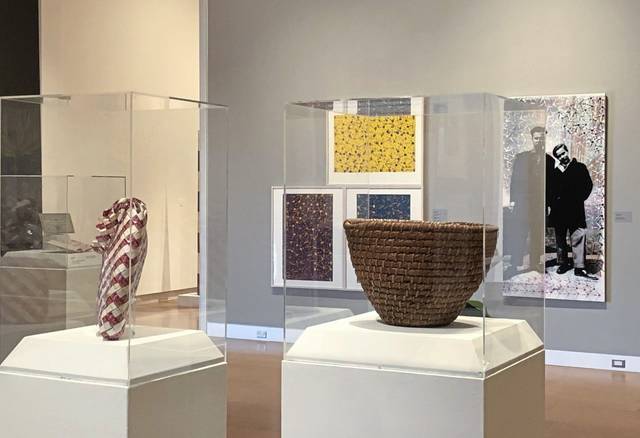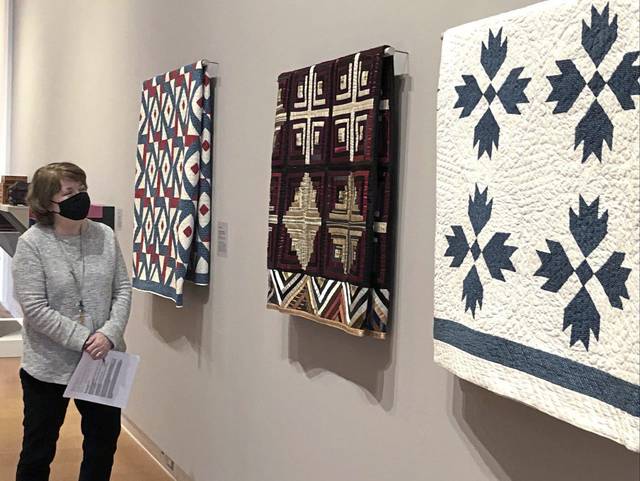Pitt students find patterns for The Westmoreland's new exhibition
In a first-ever collaboration, students from the University of Pittsburgh chose works for a new exhibition at The Westmoreland Museum of American Art.
“Pattern Makers” will be on view beginning Sunday, when the Greensburg museum reopens to the public.
The exhibition “tracks the presence and meanings of patterns across a selection of works from The Westmoreland’s collection that are not often on view,” according to the museum. “To make this exhibition, students from the Department of History of Art and Architecture at the University of Pittsburgh have mined the museum’s collection storage to discover new relationships between objects, revealing patterns that connect diverse works of different styles and periods.”
The students’ work was an exercise for a curatorial practicum led by assistant professor and academic curator Alex Taylor.
It began when a museum board member inquired whether The Westmoreland was part of Collecting Knowledge Pittsburgh, a consortium funded by the Mellon Foundation that placed Pitt students in local museums to gain experience in their particular study areas.
The Westmoreland was not involved, but the question led to contact with Taylor. He said that the consortium was no longer but he was still interested in a collaboration with The Westmoreland.
“We basically formatted it so that students got to hear from senior team leaders about all aspects of the museum,” said Barbara Jones, The Westmoreland’s chief curator. “Alex created a class schedule and a syllabus, and his whole idea was for (the students) to learn about public collections and how to develop an exhibition.
“(Class members) broke up into three groups and each was to create an exhibition proposal, and those three proposals would be presented to our senior team. The team would critique them and select the one that we thought would be the most accessible exhibition,” Jones said.
“They presented three really interesting ideas,” she said. “They were really critical about how they looked at the collection and the images they picked, and why they picked them.
“We loved the first two (concepts), but from the very beginning, I thought this one was the most completely formed. I could see it. As soon as they started talking about it, I could visualize it.”
“Pattern Makers” includes 67 works in various media from the museum’s permanent collection, placed in 12 clusters. The final choices were winnowed down from a list of about 300.
“I started by looking at what caught my eye,” said class member Isaiah Bertagnolli, who is working on a Ph.D. in the history of art and architecture. Among his choices were abstract paintings and quilts that he thought resembled paintings.
Bertagnolli said the experience will help him with his comprehensive exam in the area of curating. He said he “walked away with a better grasp of how to write exhibition labels.”
Undergraduate art history student Annie Abernathy said she selected works with “overarching themes of folklore, nostalgia and a rosy view of America.”
“This is the first time I’ve had the beginning-to-end experience of planning an exhibition,” she said. “I’d like to work as a curator in a museum, and this really solidified my interest.”
Other members of the curatorial team were Taylor, Alan London, Katie Loney, Janina Lopez, Emily Mazzola, Morgan Powell, Olivia Rutledge and Vuk Vukovic.
The two unused exhibition concepts haven’t been discarded, Jones said.
“The others were about stories that the collection can tell, but they weren’t necessarily evident when you just looked at the images,” she said. “The other two concepts will be used when we reinstall the permanent collection. We’ll bring out a lot of those stories that are really fascinating.”
Running through May 9, “Pattern Makers” is accompanied by a smaller exhibition, “Surface-Texture-Materials,” featuring more works from the permanent collection.
Upon reopening, The Westmoreland’s hours will be 10 a.m.-5 p.m. Wednesdays-Sundays. Visitors are required to register online in advance, wear face coverings and practice social distancing.
Admission remains free.
Details: thewestmoreland.org
Shirley McMarlin is a Tribune-Review staff writer. You can contact Shirley by email at smcmarlin@triblive.com or via Twitter .
Remove the ads from your TribLIVE reading experience but still support the journalists who create the content with TribLIVE Ad-Free.


